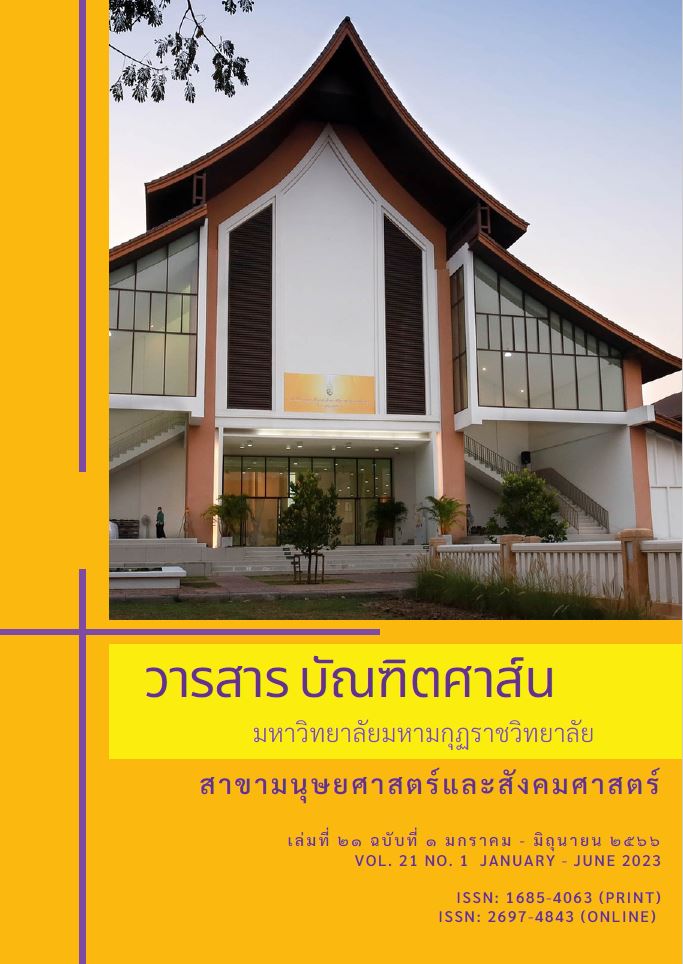บูรณาการการแก้ปัญหาโรคทางจิตด้วยพุทธจิตวิทยา
คำสำคัญ:
โรคทางจิต, การแก้ปัญหาโรคทางจิต, พุทธจิตวิทยาบทคัดย่อ
บทความนี้เป็นส่วนหนึ่งของงานวิจัย/ดุษฎีนิพนธ์เรื่อง “บูรณาการการแก้ปัญหาโรคทางจิตด้วยพุทธจิตวิทยา ” มีวัตถุประสงค์เพื่อ 1) เพื่อศึกษาการแก้ปัญหาโรคจิต 2) เพื่อศึกษาหลักพุทธธรรมเกี่ยวกับการแก้ปัญหาโรคจิต 3) เพื่อบูรณาการการแก้ปัญหาโรคจิตด้วยพุทธจิตวิทยา 4) เพื่อนำเสนอองค์ความรู้เกี่ยวกับ“รูปแบบการแก้ปัญหาโรคทางจิตด้วยพุทธจิตวิทยา” โดยมีระเบียบวิธีการวิจัย คือ เป็นงานวิจัยเชิงคุณภาพแบบเอกสาร (Documentary Qualitative Research) โดยมีวิธีวิเคราะห์เนื้อหาจากเอกสารวิชาการ วิเคราะห์หลักพุทธธรรมจากพระไตรปิฎกและอรรถกถาและสัมภาษณ์เชิงลึก (In-depth interview) ผู้ทรงคุณวุฒิจำนวน 11รูป/คน ผลการวิจัยพบว่า โรคทางจิตครอบคลุมโรคทางจิตเวชและโรคเจ็บป่วยทางจิต โรคทางจิตมีสาเหตุมาจากการกระทบกระเทือนทางจิตและสภาพทางแวดล้อม การรักษาใช้วิธีการให้ยาและวิธีจิตบำบัดซึ่งเป็นวิธีทางจิตวิทยาที่เจริญทางตะวันตก ส่วนป้องกันโรคทางจิตครบวงจรต้องอาศัยความร่วมมือทั้งผู้ป่วย ผู้ดูแล ผู้รักษา และสิ่งแวดล้อม
หลักพุทธธรรมที่ใช้ในการรักษาโรคทางจิต คือ หลักอริยสัจ 4 ในฐานะที่เป็นหลักการตรัสรู้ของพระพุทธเจ้าทุกพระองค์ หลักไตรสิกขาเป็นกระบวนการรักษา และสัญญา 10 ในฐานะเป็นภาคสร้างปัญญารักษาโรค การใช้หลักทั้ง 3 นี้ต้องเป็นไปร่วมกัน สัมพันธ์กันเป็นธรรมสมังคี กายและจิตสัมพันธ์กันต้องรักษาไปด้วยกัน พุทธจิตวิทยาบูรณาการรักษาโรคทางจิตดูแลทั้งจากภายนอกสู่ภายใน และจากภายในสู่ภายนอก ระดับเบื้องต้นต้องควบคุมดูแลพฤติกรรมตนเองทั้งทางกายและวาจา ประเมินและรายงานตนเอง ยอมรับความผิดพลาดแล้วปรับปรุงใหม่ รวมทั้งการสื่อสารที่เป็นประโยชน์ต่อการรักษา เรียกว่า จิตวิทยาให้การแนะนำ ระดับกลางใช้สมาธิเข้าสงบระงับ อาศัยอำนาจแห่งสมาธิเข้าช่วยเหลือจนเกิดความเปลี่ยนแปลงทางจิตมาสู่ความเปลี่ยนแปลงทางกายตามหลักวิทยาศาสตร์ส่วนในขั้นละเอียดนั้นใช้ปัญญาบูรณาการกับสมาธิขจัดโรคทางจิตที่ฝังลึกขั้นอนุสัย ได้แก่ อวิชชาและอุปาทาน ให้หมดไปด้วยการใช้สัญญากำหนดหมายไปสู่ปัญญาพิจารณาเห็นความจริง
เอกสารอ้างอิง
พุทธทาสภิกขุ, ยาระงับสรรพโรค, กรุงเทพ: ธรรมทานมูลนิธิ.
พระพรหมคุณาภรณ์ (ป.อ.ปยุตฺโต). พุทธธรรม ฉบับปรับปรุงและขยายความ. (พิมพ์ครั้งที่ 11).
(กรุงเทพมหานคร : โรงพิมพ์สหธรรมมิก จำกัด, 2552.
สมเด็จพระญาณสังวร สมเด็จพระสังฆราช สกลมหาสังฆปริณายก. การบริหารทางจิต สำหรับผู้ใหญ่.
กรมวิชาการกระทรวงศึกษาธิการจัดพิมพ์. กรุงเทพ : โรงพิมพ์ครุสภาลาดพร้าว.
สมพร บุษราทิจ และคณะ. จิตเวชทันยุค 2551. กรุงเทพมหานคร : โรงพิมพ์เรือนแก้วการพิมพ์, 2550.
องฺ. ทสก. 24/99/216.
ดาวน์โหลด
เผยแพร่แล้ว
รูปแบบการอ้างอิง
ฉบับ
ประเภทบทความ
สัญญาอนุญาต
ลิขสิทธิ์ (c) 2023 มหาวิทยาลัยมหามกุฏราชวิทยาลัย

อนุญาตภายใต้เงื่อนไข Creative Commons Attribution-NonCommercial-NoDerivatives 4.0 International License.
บทความวิชาการและบทความวิจัยในวารสารฉบับนี้ถือเป็นความรับผิดชอบของผู้เขียนเท่านั้น บทความที่ได้รับการตีพิมพ์ในวารสารบัณฑิตศาส์น ถือเป็นลิขสิทธิ์ของมหาวิทยาลัยมหามกุฏราชวิทยาลัย ตามพระราชบัญญัติลิขสิทธิ์



